Rock of Cashel
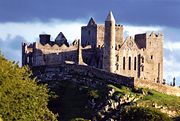

The Rock of Cashel (Irish: Carraig Phadraig), also known as Cashel of the Kings and St. Patrick's Rock, is a historic site in Ireland's province of Munster, located at Cashel, County Tipperary. The Rock of Cashel served as the traditional seat of the Kings of Munster for several hundred years prior to the Norman invasion, though few remnants if any of the early structures survive. The majority of buildings on the current site date from the 12th and 13th centuries. Cashel is reputed to be the site of the conversion of the King of Munster by St. Patrick in the 5th century A.D. The buildings which crown the Rock of Cashel present a mass and outline of great complexity, rivalling other sites in western Europe. The complex has a character of its own, unique and native, and is one of the most remarkable collections of Celtic art and medieval architecture to be found anywhere in Europe. According to local lore, the Rock of Cashel originated from Devil's Bit when St. Patrick banished Satan from a cave, resulting in the Rock to land in Cashel.
Buildings on the Rock
The earliest and tallest of the Cashel edifices is the round tower, a very well preserved 28 metre (90 feet) high example, which dates from c.1100. Its entrance is 12 feet from the ground, necessitated by a shallow foundation (about 3 feet) typical of round towers. The tower was built using the dry stone method. Modern conservationists have filled in some of the tower with mortar for safety reasons.

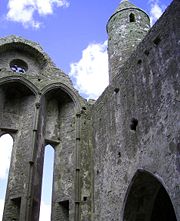
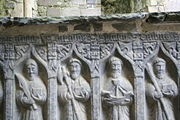
The Chapel of King Cormac, Cormac's Chapel, was begun in 1127 and consecrated in 1134. It is a very sophisticated structure, unlike most Irish Romanesque churches which are simple in plan with isolated decorated features. The Abbot of Regensburg sent two of his carpenters to help in the work and the twin towers on either side of the junction of the nave and chancel are strongly suggestive of their Germanic influence, as this feature is otherwise unknown in Ireland. Other notable features of the building include interior and exterior arcading, a barrel-vaulted roof, a carved tympanum over both doorways, the magnificent North Doorway and Chancel Arch. It also contains one of the best preserved Irish frescos from this time period.
The Cathedral, built between 1235 and 1270, is an aisle-less building of cruciform plan, having a central tower and terminating westwards in a massive residential castle. The Hall of the Vicars Choral was built in the fifteenth century. The vicars choral were laymen (sometimes minor canons) appointed to assist in chanting the cathedral services. At Cashel there were originally eight vicars choral with their own seal. This was later reduced to five honorary vicars choral who appointed singing-men as their deputies, a practice which continued until 1836. The restoration of the Hall was undertaken by the Office of Public Works as a project in connection with the European Architectural Heritage Year, 1975. It is now the building through which visitors enter the site.
In 1647, during the Irish Confederate Wars, Cashel was sacked by English Parliamentarian troops under Murrough O'Brien, 1st Earl of Inchiquin. The Irish Confederate troops there were massacred, as were the Roman Catholic clergy, including Theobald Stapleton. Inchiquin's troops also looted or destroyed many important religious artifacts.
In 1749 the main cathedral roof was removed by Archbishop Arthur Price.
Other features
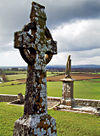
Victorian gravestone cross at the Rock.
|
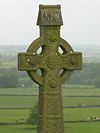
Victorian gravestone cross at the Rock.
|
The grounds around the buildings are home to an extensive graveyard, which includes a number of high crosses, such as those pictured. The entire plateau atop the rock, on which the buildings and graveyard lie, is walled. Scully's Cross, one of the largest and most famous high crosses on Cashel, originally constructed in 1867, was destroyed in 1976 when lightning struck a metal rod that ran the length of the cross. The remains of the top of the cross now lie at the base of the cross adjacent to the rock wall.
External links
- Rock of Cashel on Heritage Ireland site
- Site about Tipperary with information and images of Cashel
- Photo gallery from Rock of Cashel
|
|||||||||||||||||||||||
